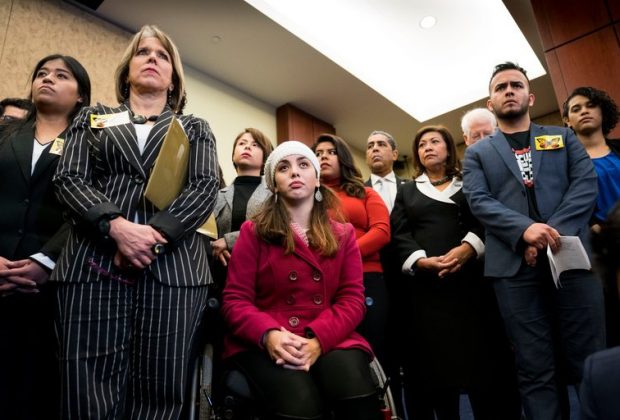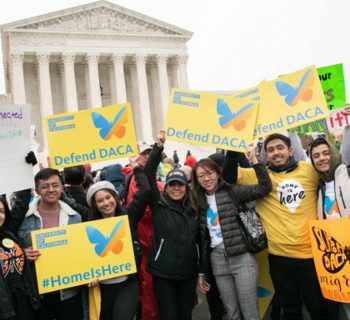By Tom B. Edsall ~ NY Times ~ February 1, 2018
President Trump’s immigration proposal has put Democrats in a bind; they know it and he knows it.
Trump’s immigration “framework” — first outlined on Jan. 25 — represents an unusually sophisticated strategy. He proposes to more than double the number of Dreamers granted a path to citizenship, a significant concession to Democrats.
In return, he seeks approval of a set of policies strongly opposed by the left, each of which is designed to stem what Trump sees as a threatening increase in the nonwhite population of the United States.
What kind of numbers are we talking about? According to the Pew Research Center:
In 2014, immigrant women accounted for about 901,000 U.S. births, which marked a threefold increase from 1970 when immigrant women accounted for about 274,000 births. Meanwhile, the annual number of births to U.S.-born women dropped by 11 percent during that same time period, from 3.46 million in 1970 to 3.10 million in 2014.
There are now an estimated 690,000 registered Dreamers in the United States, all of whom were brought to this country as children before 2007. Trump’s offer would increase the number offered a path to citizenship to 1.8 million by adding those who are eligible for DACA (Deferred Action for Childhood Arrivals), but who never registered.
For a Democratic Party whose electoral strength depends on Hispanic support (64 percent of Latinos identified with or leaned toward the Democratic Party in 2016) preventing the deportation of the Dreamers and providing them with legal status has become a matter of political necessity.
Trump, acutely aware of the importance of DACA to Democrats, deliberately turned the status of Dreamers into a crisis on Sept. 5 when he ended the Dreamers program.
Since then, DACA has been the subject of constant debate and negotiation. Democrats have continued to threaten to shut down the government, when the Treasury runs out of money on Feb. 8, if no favorable agreement can be reached.
Trump’s proposal more than meets Democratic demands on DACA. But in return Trump wants Democrats to swallow three proposals of varying unpalatability.
First, the creation of a $25 billion fund for construction of a southern border wall to prevent illegal entry to the United States, primarily by undocumented Hispanics.
Second, a shift in immigration priorities from family reunification to a merit system granting entry to workers with relatively high skills. This would require limiting reunification preferences to minor children and spouses, while eliminating them for parents, siblings and adult children, what critics call “chain migration.” These steps would reduce immigration from developing countries: The two top countries of origin benefiting from family reunification policies are Mexico and the Dominican Republic.
Third, an end to the Diversity Immigrant Visa Program. The countries providing the largest numbers of immigrants under the lottery visa program, according to the State Department, are Cameroon, Congo, Liberia, Egypt, Iran, Nepal, Ukraine and Uzbekistan.
The greatest unknown is how immigration reform will influence the voting behavior of the white working class.
In a Jan. 29 Vox essay, “The math is clear: Democrats need to win more working-class white votes,” Ruy Teixeira, a senior fellow at the liberal Center for American Progress, writes that Democrats seeking to regain control of Congress may be forced to mute their opposition to Trump immigration provisions they find offensive.
Teixeira argues that
The view that Democrats can get along without working-class white voters is simply wrong. It reflects wishful thinking and a rigid set of political priors — namely, that Democrats’ political problems always stem from insufficient motivation of base voters — more than a cold, hard look at what the electoral and demographic data say.
The problem for Democrats is that not only do they need to improve margins among white working-class voters but they cannot allow a repetition of the minority voting patterns in 2016. That year, black turnout fell to 59.6 percent from 66.6 percent in 2012; and Clinton won 66 percent of the Latino vote, five percentage points less than President Barack Obama in 2012.
Doug Jones’s December victory in the Alabama Senate race demonstrated how crucial black voters are to Democrats: In that close contest, African-Americans, 92 percent of whom voted for Jones, made up 29 percent of the electorate. They are 26 percent of the voting age population.
The conflicts the Trump proposals present for Democrats are most painful to Hispanic and black elected officials.
In a statement, Rep. Michelle Lujan Grisham, Democrat of New Mexico and chairwoman of the Congressional Hispanic Caucus, attacked Trump’s demands:
The White House is using Dreamers to mask their underlying xenophobic, isolationist, and un-American policies, which will harm millions of immigrants living in the United States and millions of others who want to legally immigrate and contribute to our country.
Despite these complaints, there are many political analysts sympathetic to the Democratic plight who contend that Trump has boxed Democrats in.
Steven Gold, a sociologist at Michigan State University, emailed me:
Many Democrats fear that extensive investments and political posturing made on behalf of immigrants will be regarded as of little value to a large swath of independent voters whose support Democrats need to increase their representation in Congress.
In a reference to the demonstrated electoral liabilities of so-called “identity politics,” Gold argued that concerned Democrats worry that
by emphasizing particularistic rather than practical issues with a broad impact, they will once again lose the politically advantageous position that appears to be taking shape for them in 2018 and 2020.
More bluntly, Nolan McCarty, a political scientist at Princeton, declared in an email responding to my inquiry:
The Democrats don’t have a lot of good options other than to support it enough that it can pass with unified Republican support.
McCarty explained further:
Blocking it would allow the Trump Administration to suggest that the Democrats were willing to trade Dreamers for “lottery” and “chain” migration, as well as position them as soft on border security.
An advantage in accepting the Trump proposal, McCarty continued,
is that border security appropriations and visa programs can be fixed if the Democrats regain control. The effects of Dreamer deportations and/or sending them back into the shadows is far less reversible.
Trump and Stephen Miller, a senior adviser to the president, have clearly made this calculation and decided that they win either way. Take, for example, the following tweet from the president’s account on Jan. 27:
I have offered DACA a wonderful deal, including a doubling in the number of recipients & a twelve year pathway to citizenship, for two reasons: (1) Because the Republicans want to fix a long time terrible problem. (2) To show that Democrats do not want to solve DACA, only use it!
Robert L. Borosage, president of the left-liberal Institute for America’s Future, argued that Democrats should make every effort to get the immigration issue off center stage. “In my view,” Borosage said in an email, “Trump wins as long as we’re arguing about this. So it would be good to get this done soon.”
Borosage went on:
What should Democrats do? I’d take the deal, after pushing for concessions on family unification and lottery system, and pushing against full commitment of $25 billion as an outrage.
Bruce Cain, a political scientist at Stanford, makes the case that political logic favors Democratic cooperation with Trump on immigration:
If the Democrats compromise on a few of the non-DACA items and the (Congressional) Republican position is no DACA relief, then the Republican position becomes untenable and looks as though are caving to their extreme nativist faction. And if the Democrats make their position a clean bill on DACA and no compromise on the other items, it hands the Republicans a perfect wedge item going into the 2018 election, possibly keeping them in control of both houses.
In fact, I found an unexpectedly high percentage of the experts I contacted — most of whom are sympathetic to the plight of immigrants — in general agreement that Democrats would be wise to come to some kind of an agreement with Trump.
Daniel Hopkins, a political scientist at the University of Pennsylvania, noted, for example, that the public supports both “a pathway to citizenship for Dreamers” and “enhanced border security.” But, he warned,
in today’s political climate, it’s very hard to imagine a deal that will placate both sides for long, as both parties seem to define winning in zero-sum terms.
So far at least, arguments in favor of cutting a deal are not selling with the Democratic leadership — although the leaders’ position may be more of a bargaining tactic than a principled stance.
Chuck Schumer, the Senate Democratic leader, tweeted on Jan. 26 that “this plan flies in the face of what most Americans believe,” adding
While @realDonaldTrump finally acknowledged that the Dreamers should be allowed to stay here and become citizens, he uses them as a tool to tear apart our legal immigration system and adopt the wish list that anti-immigration hard-liners have advocated for years.
Nancy Pelosi, the Democratic House leader, was more outspoken. In a Jan. 26 statement that received wide press coverage, she described Trump’s proposal as “part of the Trump Administration’s unmistakable campaign to make America white again.”
After Trump reiterated his immigration proposals in his State of the Unionaddress Tuesday night, Pelosi stood firm in her opposition:
The president represents himself as generous towards Dreamers, but he is holding them hostage with the most extreme anti-immigrant agenda in generations. We heard more insulting words of ignorance and prejudice towards patriotic immigrant families last night.
In a detailed critique of the Trump proposal, William Frey, a demographic specialist at Brookings, argued that
the so-called compromise between DACA and border security is extremely disproportional — weighted heavily toward the latter which is characterized by simple bumper sticker messages about family migration, border security and the visa lottery that is aimed at appealing to the extreme anti-immigrant wings of Trump’s Republican base.
Frey wrote in his email that he could
not imagine Democratic senators or congressmen agreeing to anything close to this plan — in light of their base which not only includes Hispanics, Asian-Americans and other minorities — but also rising support in recent state and local elections they have received from suburban college graduate women and millennials.
Nonetheless, in a Washington Post op-ed published in 2015, Frey pointed out that
Democrats cannot make the politics of fear go away simply by courting the young-adult and minority voting blocs. While it is true that the supersize turnout and support of those groups helped elect President Obama twice, the white portion of the electorate, which votes strongly Republican, underperformed in support of John McCain in 2008, and white turnout was down in 2012.
There is, Frey continued, “a sharp lag in diversity between the overall population and the portion that turns out on Election Day.” It is “the older electorate — those most greatly fearing change,” he wrote,
that will be gaining as baby boomers continue to age. By my calculation, the number of (mostly white) eligible voters over age 45 will be 26 percent larger in 2024 than those under age 45. This disparity will be further widened by the higher turnout of older white voters, who may not determine future elections but will continue to have a strong voice.
When I asked him if there was a disparity between his recent comment to me and the Post op-ed, Frey wrote back:
I stand by the fact that the politics of fear (to older non-college whites) can work to some extent. But I also think white women, especially college graduate white women, can help to mute the impact on the immigration issue because of their disdain for Trump. If Dems are looking at 2018, it’s not just the immigration issue that is important to those women but Trump’s stance on women’s issues in general — critical of planned parenthood, abortion, his support of Roy Moore in Alabama, his disdain for political correctness and his overall boorishness may counter whatever gains he may get, on immigration, from older white non-college men and women (and even the latter support may be more tenuous). Another group is millennials, now strongly anti-Trump, who could be motivated to turn out in greater numbers.
In short, the base that will respond to Trump playing the “immigration card” may be dwindling in light of his other positions and demeanor since in office — including his handling of the Russian investigation. I think the Democrats are counting on that.
It may seem surprising now, but the Pew Research Center found that from 1994 to 2006 there was very little difference between the views of Republican and Democratic voters on immigration. Since that time they have diverged sharply.
In response to the question, “Which comes closer to your view, ‘immigrants today strengthen the country because of their hard work and talents,’ or ‘immigrants today burden the country by taking jobs, housing and health care’?” there was almost no difference in the responses of Democrats and Republicans in 2006.
In 2016, 78 percent of Democrats had a positive view of immigration compared with 35 percent of Republicans.
In a circumspect analysis of the immigration issue, Morris Levy, a political scientist at the University of Southern California, argued in an email that public views of immigration are complex and sometimes contradictory:
It is tempting to read polls as a reflection of “what the public wants” on some issue. Politicians and activists routinely portray poll results in this way when they seem to lend popular legitimacy to their preferred programs. The reality is more complicated. The great majority of Americans do not hold clear, stable, well-defined positions on almost any of these issues.
Levy wrote that his “sense” is that a final deal
could include funding for the wall, which was in fact not an unpopular policy idea until it became a signature issue in Trump’s campaign, and possibly also curtailing the diversity visa lottery.
He cautioned, however, that it is
unlikely that the Democrats would accede to anything approaching the kinds of sweeping cuts to family-based admissions that the administration has proposed.
Even if much of the public has ambivalent feelings about immigration, that doesn’t mean the issue will have no more than a moderate impact on the election.
Animosity to immigration was crucial to Trump’s Electoral College victory, especially in rural Rust Belt counties.
But the legislative framework Trump proposed is by no means risk-free for Republicans. Emily Ekins, director of polling at the libertarian Cato Institute, wrote me that:
This framework may anger a critical component of Trump’s base if they come to view it as “amnesty.” This in turn could impact turnout in the 2018 midterms.
Crucially, Ekins noted that immigration attitudes were
one of the strongest predictors of Obama-Trump voters. Thus, if these voters come to believe that Trump has betrayed them on one of their primary reasons of support, they may be less mobilized come the 2018 midterms and perhaps in 2020. While Trump’s supporters have stuck with him throughout numerous controversies, perceived betrayal on immigration might be the one issue that could cost Trump his base.
From another vantage point, Democratic House incumbents face an exceptionally large number of primary challengers this year, many of them from the left, supported by such groups as Justice Democrats, Indivisibleand other insurgent organizations.
For these challengers, a failure to protect the Dreamers would be a powerful issue in a primary contest, a potential threat increasing pressure on current Democratic members of Congress to reach an agreement. Further complicating the matter, however, is that Democratic primary challengers are equally likely to accuse incumbents of selling out if they vote to support funding for the border wall.
For Republicans, it would be difficult to defend televised deportations of hard-working, law-abiding young men and women to countries of which they have little or no memory.
David Leege, an emeritus political scientist at Notre Dame, has trenchantly observed that
There is more political capital in an issue left festering than in a problem solved.
As both parties struggle with the logistical and moral quagmire that the immigration issue represents, they face problems that they need to solve and not to solve at the same time.
Source: Tom B. Edsall ~ NY Times






